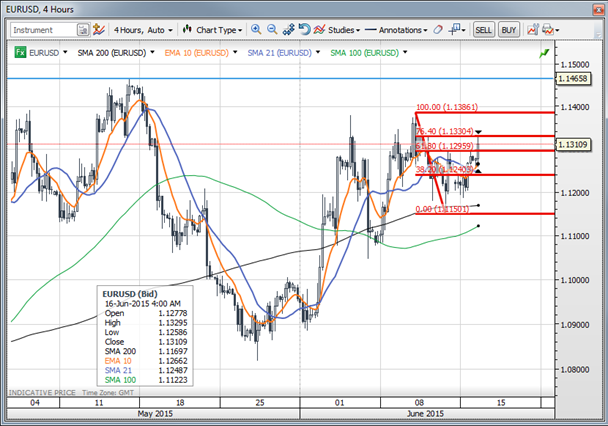Haruhiko Kuroda, the governor of the Bank of Japan, was out overnight explicitly retracting his comments from last week, saying they weren’t aimed at the nominal exchange rate.
The original comment was on the “effective real rate”, which is adjusted for inflation, but the signal value of his retraction is far more important than the semantics. He also tied himself into knots saying that he both didn’t mean to say that the BoJ is not seeking a weaker nominal yen, and that he didn’t say a weaker nominal yen is needed for the BoJ’s price target.
USDJPY spiked higher on the comments.
The situation surrounding Greece is taking on a new level of seriousness, as the Greek leadership indicated it will not present any new plan to the Eurogroup meeting later this week and that its creditors would need to take its plan or leave it.
Meanwhile, reports are swirling that the EU is drawing up a contingency plan and could implement capital controls as soon as this weekend if necessary. Clearly, we are rapidly nearing the zero hour for something to happen, and as the euro maintains rather high levels through all of this – the bears should be very nervous.
The Reserve Bank of Australia minutes showed a relatively dovish RBA, but not more dovish than the market has already priced in. Both the market and the RBA seem to be awaiting incoming data, since the RBA’s comments on desiring a weaker currency don’t seem to be getting much traction at the moment: “A lower exchange rate would have an immediate beneficial effect on some sectors such as tourism…it would need to be lower for a sustained period to have a significant effect on large investment decisions in other trade-exposed sectors.”
The key focus on the horizon is the Federal Open Market Committee meeting tomorrow, where it is all about the spin that the Fed offers on its assessment of the economy and how itchy its trigger finger is getting on the timing of the first rate hike.
The high probability scenario is a rather neutral statement, as the Fed probably feels that it has enough time to react if the data accelerates to the strong side in June and July, and as there isn’t enough evidence so far, in their minds, that the bounce-back is strong enough to require signalling anything dramatically different than the market’s assessment of a either a September or December rate move.
While the least likely surprise scenario (from the statement, economic or policy projections) would be anything that shifts the first anticipated rate hike further out the curve, the question is whether there will be enough to excite the USD bulls into taking on fresh positions (positioning is still a potential issue for this market, particularly in EURUSD) or whether the market would prefer to see another cycle or two of data to gain confidence in its convictions.
Chart: EURUSD – 4-hour
The 1.1295 area was a key local Fibonacci (61.8%) level that gave way this morning and encourages a look at the 1.1380+ highs if the last FIbo at 1.1331 is taken out, with anything above that possibly a function of the USD reaction to tomorrow’s FOMC meeting. Bears need a quick, large reversal here to find any argument for lower levels.

The G-10 rundown
USD: Looking weak amid a possibly justified stance that the FOMC provides little to move the market tomorrow.
EUR: Squeezing higher through local 1.1300 resistance suggests a test of the 1.1380+ recent highs and possibly beyond, as bears should be particularly concerned that negative Greece news flow not weighing more heavily on the single currency.
JPY: Kuroda backtracks and keeps JPY on the defensive in the crosses. But there is still some chance that the Friday BoJ sees the bank expressing hope that it's current policy mix will do enough.
GBP: Sterling on a roll ahead of CPI data today and Bank of England Minutes tomorrow – in GBPUSD this feels like a squeeze on USD longs ahead of the FOMC rather than any strong fundamental reason to buy Sterling, but the break of important local resistance suggests risk for a test of the 1.5800+ highs.
CHF: The SNB will likely begin to talk up its intention to do something about the strong CHF – but what? Intervention seems the only possible route. Interesting that CHF hasn’t seen more upside after this latest round of developments on Greece.
AUD: AUDUSD biding its time in the lower range as AUD can’t rally even against the weak USD – likely on the risk off tone of the moment. Next step will depend on FOMC meeting tomorrow.
CAD: USDCAD easing back lower – 1.2200 the key support around FOMC and then focus shifts to Friday’s data out of Canada (CPI and retail sales).
NZD: Remaining weak here on weak risk appetite and after recent very dovish Reserve Bank of New Zealand meeting.
SEK: The bounce in EURSEK may be mostly about weak risk appetite – may steer clear of those range lows as long as we are posting new lows in equities.
NOK: Norges Bank on Thursday the next focus. NOK weakness at the moment a function of euro strength and weak risk appetite.
Upcoming Economic Calendar Highlights (all times GMT)
- UK May CPI/RPI/PPI (0830)
- Germany Jun. ZEW Survey (0900)
- Eurozone ECB’s Mersch to Speak (1100)
- US May Housing Starts and Building Permits (1230)
- New Zealand Q1 Current Account Balance (2245)
- Japan May Trade Balance (2350)
